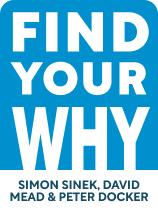

This article is an excerpt from the Shortform book guide to "Find Your Why" by Simon Sinek, David Mead, Peter Docker. Shortform has the world's best summaries and analyses of books you should be reading.
Like this article? Sign up for a free trial here .
What is the meaning of a purpose discussion? What are the steps for conducting a purpose discussion?
A purpose discussion is a process Find Your Why author Simon Sinek created with co-authors David Mead and Peter Docker to identify your purpose. The authors’ step-by-step process can be followed with a partner to create an individual purpose statement, or applied in a group discussion to come up with a team or organization’s purpose.
Keep reading for a complete guide to conducting a purpose discussion for both individuals and teams.
The Purpose Discussion
To determine your Why and come up with a written statement, Sinek and his co-authors created a step-by-step process that individuals and groups can follow in a group discussion or workshop. Sinek’s process to find your purpose helps you or your team explore past experiences for insight into what moves you.
In this process, you’ll identify important stories in your personal or company experience, share them with a partner or group facilitator, and pull out themes. You’ll then distill these themes to write your Why or purpose statement.
(Shortform note: While Sinek argues that you can find your purpose by looking inward, Viktor Frankl argues the opposite in Man’s Search for Meaning. He contends that you can only find meaning out in the world—in other people or causes—not in your own mind.)
Step 1: How to Approach a Purpose Discussion
The mindset you bring to the process of finding your Why can significantly impact its success, according to the authors. So before you begin, they recommend reflecting on your attitudes and preconceptions.
Individuals: Get Into the Right Mindset
To bring the right mindset to the individual process, Sinek recommends that you:
1. Release preconceptions. Don’t expect or angle for a specific outcome. Instead, focus on telling your stories honestly, and let the process unfold. (Shortform note: This helps avoid confirmation bias—the tendency to interpret new information in a way that confirms what we already believe and one of the cognitive biases Daniel Kahneman discusses in Thinking, Fast and Slow. Confirmation bias might cause you to focus on stories that fit what you think your purpose should be, and overlook stories that don’t fit your expectations.)
2. Embrace vulnerability. The more honest and unguarded you are, the more useful this process will be. (Shortform note: If you’re hesitant about embracing vulnerability, keep in mind Brené Brown’s assertion in The Power of Vulnerability that vulnerability is a strength, as it requires more courage to share something intimate than to keep quiet for fear of being judged.)
Teams: Understand Your Starting Point
To lay the foundation for a team process of finding your purpose, the authors recommend that you:
1. Identify the scope of the team you’ll be working with. A team is a group working toward a common goal and sharing certain values. An organization can have multiple teams. For this process, you might be seeking the purpose of an entire company or of a specific team within it. (Shortform note: When you identify the scope of the team, consider that most individuals in an organization are part of multiple teams, so who is part of which team won’t always be clear-cut or readily apparent.)
If you’re working with a team within a larger organization, Sinek advises that you first identify the organization’s overarching purpose. That will ensure that the team members understand how they contribute to it. (Shortform note: In The Practice of Adaptive Leadership, the authors argue that when people understand the organization’s overarching purpose plus their specific area’s purpose, they’re invested in the success of both. This is a quality of resilient organizations that helps them adapt to new conditions and overcome novel challenges.)
2. Be aware of underlying issues that might impact the outcome of the process. Sinek warns that the team should address any problems—besides an unclear purpose—before starting the process. (Shortform note: While Sinek doesn’t offer guidance on how to address these problems before the purpose discussion, in The Culture Code Daniel Coyle identifies two foundational elements that group culture needs before working toward a shared purpose: safety and vulnerability. If the team’s culture is safe, members feel connected to each other and valued, which helps them get through problems together. If they can be vulnerable with each other, they communicate and collaborate more effectively, and they can solve problems more easily.)
Step 2: Select and Prepare Your Partner or Facilitator
In this step, you’ll choose a partner or facilitator to help you identify themes in your life or organization that suggest a purpose. Sinek recommends choosing someone who has emotional distance from the process and can be objective. They should also be curious and perceptive, so they can ask the right follow-up questions to get to the core of each story.
After choosing your partner or facilitator, ask them to view Sinek’s TED Talk about purpose, so they understand the theory behind the process they’ll facilitate. Then, brief them on their role, which is to listen to each story and ask follow-up questions to uncover why it matters. According to Sinek, the best questions:
- Follow the trail of emotional cues. For example, when someone gets emotional, ask them to describe their feelings.
- They aren’t yes or no questions. For example, ask, “How did that experience change you?” instead of, “Did that experience change you?”
- They start with What rather than Why. For example, ask, “What about that moment made you feel proud?” instead of, “Why did you feel proud at that moment?”
On the other hand, Sinek says, partners or facilitators shouldn’t offer solutions or advice, or let their preconceptions bias the process.
| How to Remain Objective It might be hard for the facilitator to stay impersonal and allow the other person to reach their own conclusions. To encourage objectivity, it might help to frame the process as a coaching session where, rather than giving advice, they’re helping you find the answers yourself. For example, a coach would: – Observe emotional cues impersonally to ask follow-up questions, instead of judging or naming the emotions they notice. – Ask questions that allow the other person to consider and construct complete answers. Thus, the person sharing stories does the mental and emotional heavy lifting, not the facilitator or partner. |
Individuals: Resist the Urge to Skip This Step
Though it’s tempting to forego a partner to save time or be self-sufficient, the authors stress the importance of not doing this on your own. That’s because your life stories will trigger emotions, and you need an objective observer to help you analyze them. (Shortform note: Not having the right partner shouldn’t prevent you from seeking out your purpose. In Designing Your Life, Bill Burnett and Dave Evans offer tools you can apply on your own, including the Life Dashboard, which allows you to take stock of how you’re doing in different areas of your life, and the Life Compass, which shows you which paths will be most fulfilling to you, considering your beliefs about life and work.)
Teams: Objectivity Is Key
If you can’t bring in someone from outside to facilitate, Sinek says it’s OK to have a team member facilitate. However, make sure they can remain objective. Also, ensure they understand that the goal of the process isn’t to revamp branding or position the company. (Shortform note: To find the right person for the job, apply Gino Wickman’s approach, outlined in Traction. Look for someone who has the talents, shares the values, and wants to do the job. In this case, you’re looking for someone who is comfortable working with groups, is objective, and wants to help the team find its purpose.)
Step 3: Gather Input for the Purpose Discussion
The third step in preparing for the process of finding your purpose is input, or determining what you’ll bring to the purpose discussion. That “input” is different for individuals versus teams. For individuals, input refers to the life stories you gather ahead of time. For teams, it refers to the people you invite to participate.
Individuals: Gather Your Stories
Before the session, come up with 10 stories that shed light on who you are. Sinek invites you to look for meaningful anecdotes, lessons, and people who shaped you. (Shortform note: To identify “meaningful” stories, consider times you experienced a “defining moment.” In The Power of Moments, Chip and Dan Heath describe defining moments as those that generate insight, pride, and connection, and are noticeably different from everyday experiences.)
Teams: Gather the Right People
The stories that will help you discover your organization’s purpose are the ones team members have lived through and are able to share. To capture those stories, first find 10-30 people to participate: enough to generate diverse perspectives and experiences, but not so many that the process becomes disorganized.
According to Sinek, participants should:
- Represent different positions and tasks on the team, vertically and horizontally.
- Be enthusiastic about being a part of the team, since they’re most likely already living the team’s purpose.
- Have been part of the team for enough time that they’ve seen its highs and lows. However, note that you can invite some newer members, too, since they have fresh insight into the team’s culture.
(Shortform note: Sinek’s ideas align closely with guidelines for team building that John Maxwell shares in The 21 Irrefutable Laws of Leadership, but Maxwell adds a point that Sinek doesn’t consider. Besides selecting for diversity, enthusiasm, and experience, Maxwell suggests you build a team with influential people who have good chemistry with you and other team members and are morally upstanding. These traits will be useful to ensure the process goes smoothly, and that they later advocate for the Why.)

———End of Preview———
Like what you just read? Read the rest of the world's best book summary and analysis of Simon Sinek, David Mead, Peter Docker's "Find Your Why" at Shortform .
Here's what you'll find in our full Find Your Why summary :
- Simon Sinek’s steps to understanding and living your purpose and your organization’s
- How to create and write your purpose statement
- What to do after you find your Why: Determine your How






